Spring 2016
Can La Tortuga Rediscover His Youth?
In the Spring of 2016, we began what will end up being a major refurbishment project on our 2007 Provan Tiger overland vehicle. We anticipate that this work will bring our vehicle back to something approaching a like new condition following the extensive travels we’ve already completed in it and in preparation for what we hope will be further overseas adventures over the next several years. As I write this article, the first portion of the task has been successfully completed and the Tiger has emerged from a four month rebuild of the living quarters and systems at the Provan factory in South Carolina. Here’s a little history to lead us into a discussion of the need for the work that has been done.
When we dropped our Tiger off at the port in October 2015 for shipment from England back to the US, it was less than five months short of being nine years old and had spent the previous five and a half years in Europe, Western Asia and North Africa; this following eighteen months traveling through Central and South America. At that time, all but eighteen months of those nearly nine years had been spent outside of the US/Canada portion of North America — more than 80% of its life had been spent overseas. Also, during that period we had been living and traveling in the Tiger a full 72 months, roughly 70% of the total time.
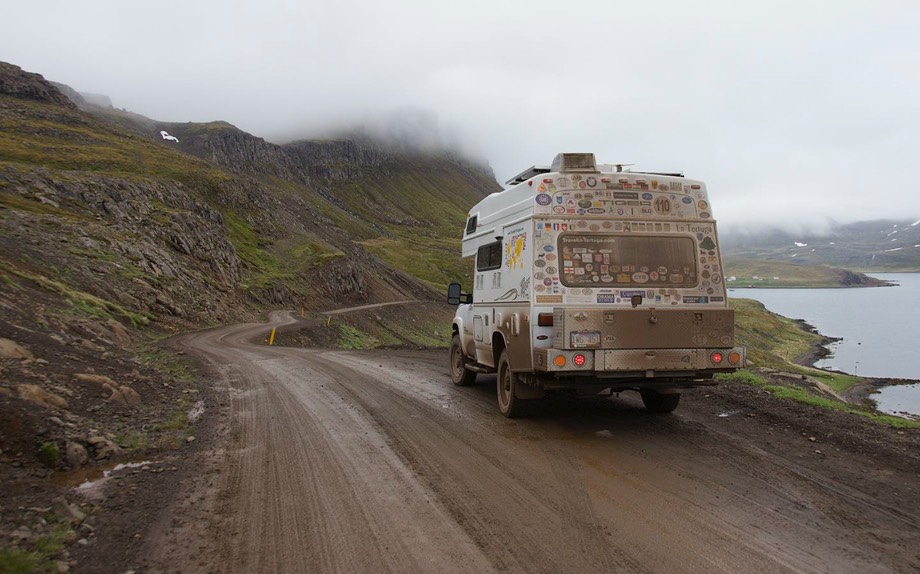
We’ve never babied our Tiger, but from the beginning we have sought to take advantage of its capabilities to travel far afield and to happily leave pavement behind whenever unpaved roads looked more interesting than their paved alternative. When our Tiger was less than six months old we drove it up both the Dempster Highway in Canada’s Yukon and Northwest Territories and the Dalton Highway, the “Haul Road”, to Prudhoe Bay in Alaska’s far north. From there we drove it south all the way to the tip of South America to visit Ushuaia, the southernmost city in the world; all this before the Tiger reached its second birthday. When we returned to the US after our journey to Prudhoe Bay and then down to Ushuaia we had put 65,000 miles on the Tiger, of which over 20,000 had been traveled on unpaved roads.
Moving forward, shortly before this story begins, when our Tiger was in its ninth year, we were in Iceland, happily splashing through rivers in the difficult to reach interior and braving the muddy roads along the northern coastline, as shown above. Along the way, from its delivery to us on March 1, 2007 to its arrival back at the factory in December 2015, our Tiger had driven 168,000 miles (270,000km), visited fifty-six countries on five continents, crossed the Arctic Circle in six of the eight possible countries in the world and given us very little trouble along the way.
So why the major refit? Simple really; it was time. We had completed our time traveling in Europe, at least for the time being, and were looking ahead to future adventures. We were noticing some areas, both in the Tiger and in the Chevrolet portions of our vehicle, that we thought could benefit from professional attention. We certainly could have soldiered on, taking care of things as they arose just as we had always done. But we felt it would be wiser to take a year between journeys to refurbish, repair, refit and otherwise prepare our vehicle for what we hope will be many more years of overseas travel. This is the path we have chosen and the process will include not only the refurbishment of our Tiger’s living quarters, but also a thorough inspection, servicing, upgrading and preparing of our Chevrolet chassis. In both cases we are not only giving attention to areas of concern, but also performing a variety of upgrades and improvements based on our experience with the vehicle. A big job to be sure, but far more affordable than starting over with a new vehicle. Besides, what’s the fun in that? We have a ton of history and a sense of shared adventure already built into our Tiger that could never be duplicated by starting over in something new.
Part One: An Extended Stay at Provan Inc. Tiger Central.
Our Tiger, La Tortuga by name, arrived at the Provan factory in Columbia, South Carolina with three fairly straightforward areas of concern. We also had a short list of systems improvements we wanted to have done while at the factory; we’ll get to those later. In correspondence with Mark Guild, the owner of Provan, now known as Tiger Adventure Vehicles, we all thought we would be set to drive off again in a repaired vehicle in six to eight weeks.
Our areas of concern were:
- Some warpage in the flooring together with deterioration of some of the wooden structural members in the lower side walls, particularly around the access door to the external storage compartment located behind the right side rear wheel and in the step well area.
- Minor but noticeable bubbling in the paint on one exterior aluminum panel. This was caused by corrosion traceable to a shipment of improperly treated aluminum Provan had received around the time of our Tiger’s construction. Fortuitously the affected panel was the same lower right side item that contained the problematic storage door.
- Extensive water staining of the cloth headliner material caused by both condensation on the inside of the fiberglass roof and water intrusion during heavy rains. This particular problem had shown up very early on in our particular vehicle and repairs had been attempted by the factory before.
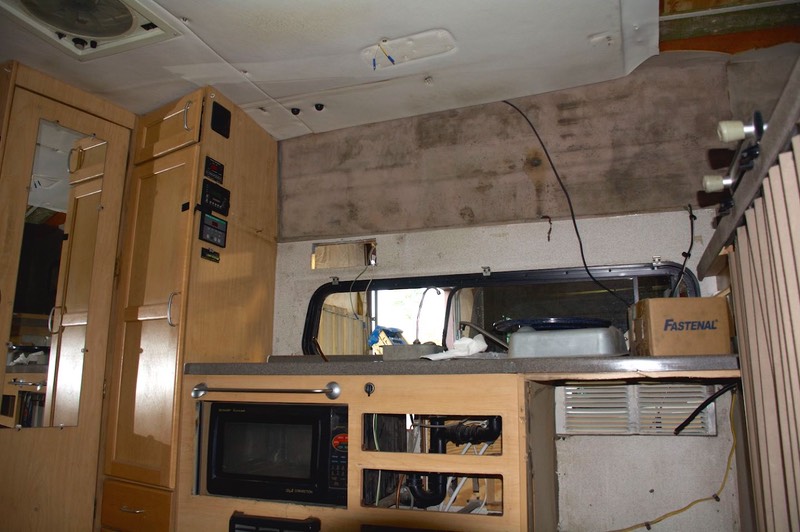
Now, all three of these issues are more cosmetic than structural and none of them would have stopped our continuing to travel in our Tiger. Nonetheless, our Tiger was back in the US for the first time in six years and now was the time to deal with them.
The Provan crew was primed and ready for our arrival and immediately began to disassemble our Tiger in order to ascertain the extent of the problems. As we had concerns about both the flooring and the roof, it soon became apparent that the disassembly would be more encompassing than we had anticipated. Over the next few days of inspection and appraisal it became obvious that in order to do the job correctly, more time would be needed and decisions would have to be made about how far we should go. Certainly the obviously bad parts of the flooring could be simply cut out and replaced, the faulty aluminum panel could be replaced and the interior of the roof could be cleaned and resealed; but from top to bottom, from owner Mark Guild right down to the newest crew member, there was an obvious commitment from the Tiger staff to do the job right at each step of the way. In full consultation with us, choices were made, estimates were approved and work was begun.
This is what transpired:
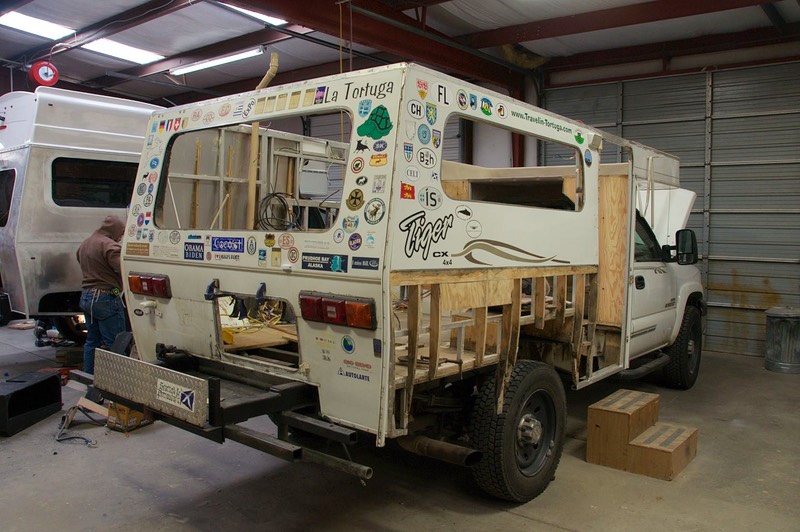
As you can see from the photos, the Tiger ended up being stripped down to the bare bones of its aluminum frame. The crew determined that the only way to properly seal the roof was to start over from the beginning and this meant removing the top. We then had the choice of whether to reinstall the original top or switch to the newer model top from the Bengal TX. This roof adds up to 3” of additional headroom, particularly in the back areas of the coach, which includes the bathroom/shower. It is also somewhat sturdier and better insulated in order to reduce condensation problems. Kathy and I were concerned about making any change to the appearance of our Tiger, which we loved, but we elected to go ahead with the all-new roof and in the end we are quite pleased with the change.
Due to the increase in height, the interior cabinets and walls would all have to be redone as well, so there were some additional costs incurred. One thing that had become immediately obvious however was that in the years since our unit was built, construction standards at Provan had been steadily improving. The cabinetry is of a much higher quality now, the bathroom walls are fiberglass, latches and hinges are better, and, with the added height, the overhead cabinets are also roomier. I believe the crew would have gone into open rebellion if asked to do a patch up job of repairs and then reinstall all the old bits. Such an approach would not have been up to their standards at all.
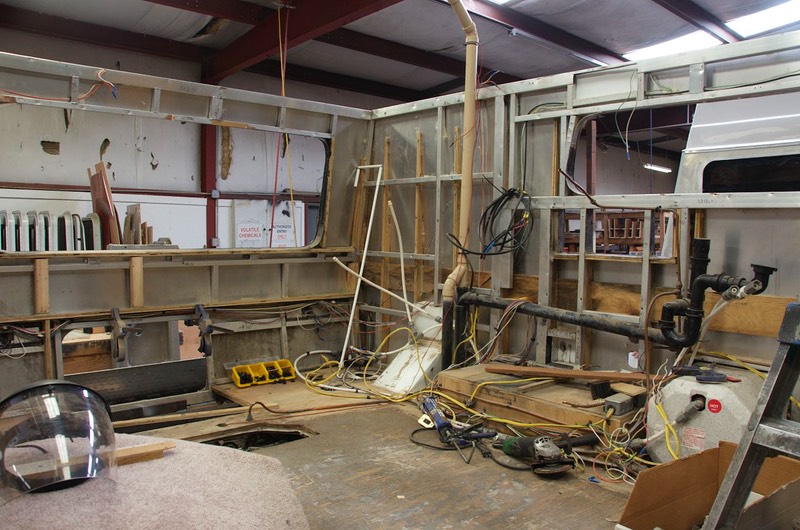
At the other end of the spectrum, the flooring project expanded to include not only the warped sections, but other areas that were not up to spec. We ended up with not only a largely rebuilt floor, but also new wheel wells, step well and basically all new lower wood sections of the sidewalls. A note here on the structure of the Bengal Tiger models. These units have a welded aluminum frame and are aluminum skinned up to the top of the sidewalls where they meet the one-piece fiberglass top. The mention of wood in the sidewalls refers to the sections that go between the vertical frame members and the aluminum skin to give a curved shape to the vehicle so the sidewalls are not just straight up and down.
By our own choice we also went ahead and had them rebuild the kitchen area so that all the cabinetry would match in color and we also asked them to raise the counter height some. The end result of all of this work is really an all new interior as you can see below. In fact, it is better than new because of all of the improvements that have been made over the years. We had already arranged for the sofa to be reupholstered and other items such as the bathroom fixtures to be replaced due to normal wear, so when we walk in the door now there is very little to be seen that is not all new. And under the skin so to speak, the insulation is all new (and much improved as it turns out), the windows in the cabover bed area are new and many other small details have been improved. We are very pleased with the result of all the work and feel certain that our coach is as ready as the Tiger crew can make it to give us many more years of travel.
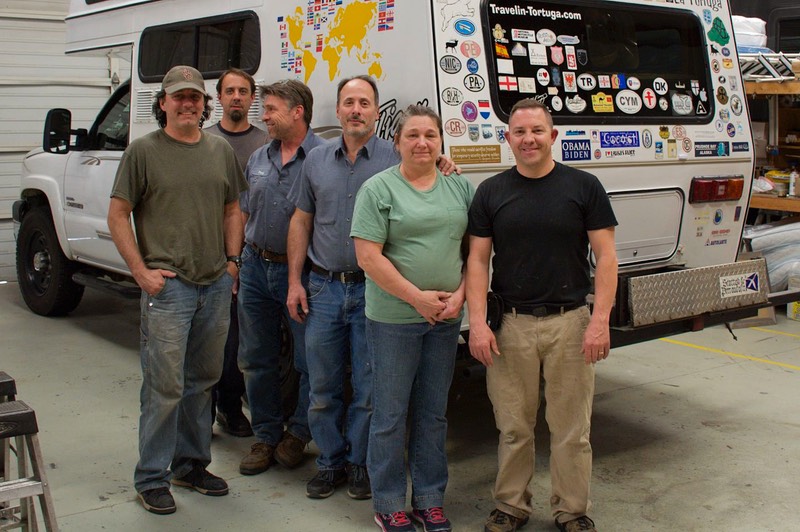
Our thanks, appreciation and friendship go to all the great folks at Tiger and most especially to the crew who did most of the work on La Tortuga: (left to right) Eric, Jay, Terry, Mike, Darlene and Chris.
System Improvements done during the interior rebuild:
During the strip down and rebuild described above, we also wanted to make some improvements to our Tiger’s various support systems. These were:
- Remove the original propane fired Onan 2500 watt a/c generator from its location under the couch at the rear of the Tiger.
- Relocate our 2000 watt Magnum inverter from the space it was occupying in our clothes closet to a new spot in the area previously occupied by the generator.
- Increase our battery bank from two to four 6-volt AGM sealed batteries, thus increasing our battery amp hour capacity from 220 to 440. Naturally we replaced the two existing batteries, which had been in service since 2009.
- Replace our two fourteen year old 120 watt solar panels with three new 160 watt panels, thereby doubling our solar capacity from 240 watts to 480 watts. In order to save work for the Tiger crew, this work was performed by our long time solar provider, Ron Wicklund at D&R Family RV in Glendale, Arizona.
- Run new 8-gauge wiring to the roof to accommodate the upgraded solar installation. Add a second 1/0 electrical cable from the engine compartment to the house batteries to further enhance our ability to charge the house batteries from the engine alternator.
- Replace our original Suburban propane furnace with an Espar diesel-fired space heater. Update 2021: We love the operation of the Espar heater; it is whisper quiet, uses much less electricity than the Suburban unit, and, of course, uses diesel fuel instead of propane. However, we would be remiss if we did not mention that in 2020, at four years of age, our unit completely self destructed and had to be replaced. Something in the rotating mass, i.e. the motor or fan assembly came apart and the unit froze up. Cost for installation of a new heater was $1438. Then, in 2021 the heater once again wouldn’t start up, and once again the cause turned out to be a problem with the motor. As we were just barely out of the one year warranty period, Espar was good enough to supply a replacement motor, but labor cost for this repair was $638. And lastly, the unit must be serviced every 1000 hours of operation; many owners carry the parts for this operation and do the job themselves; having it done at a dealer costs about $250. So in summary, yes it is a wonderful heater when it is working, but it can also be an expensive unit to maintain.
- Add an electric heating element to our propane-fired water heater to provide hot water without propane use when shore power is available or from the inverter at our option.
- Perform improvements to plumbing and wiring systems whenever possible to bring our Tiger up to current Provan building standards.
- We replaced the water pump as a precaution due to normal wear. Also, we ended up replacing the original Sharp Microwave/Convection oven because the cost of what we thought would be a minor repair to it would have exceeded the cost of a new model.
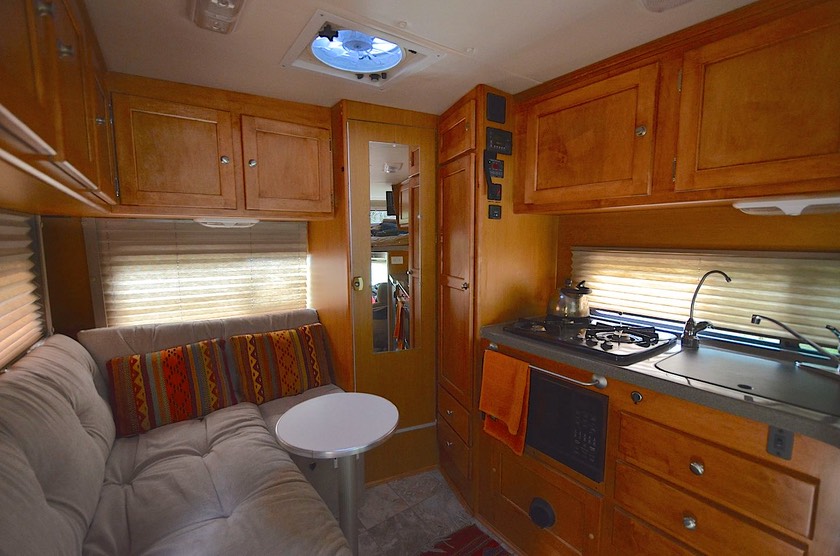
Some of these changes are pretty self explanatory, but others may raise questions for some readers.
Removing our Onan a/c generator was a decision that was two years in the making. Make no mistake, a generator can be a very useful thing to have along. Indeed, during our more than fourteen years of full-time RV travel we had always had one. However, in a small vehicle meant for international overland travel we decided that ours had become something of a luxury that we no longer needed. They can be handy, yes, but they are also heavy, expensive, use propane (in our case; other generators run on either gasoline or diesel fuel) and take up a lot of room. In addition, following the installation of a higher output engine alternator, higher capacity battery isolator and heavier wiring in 2014, we had learned that we could now charge our batteries as quickly idling the engine as we could running the generator — and with much less noise.
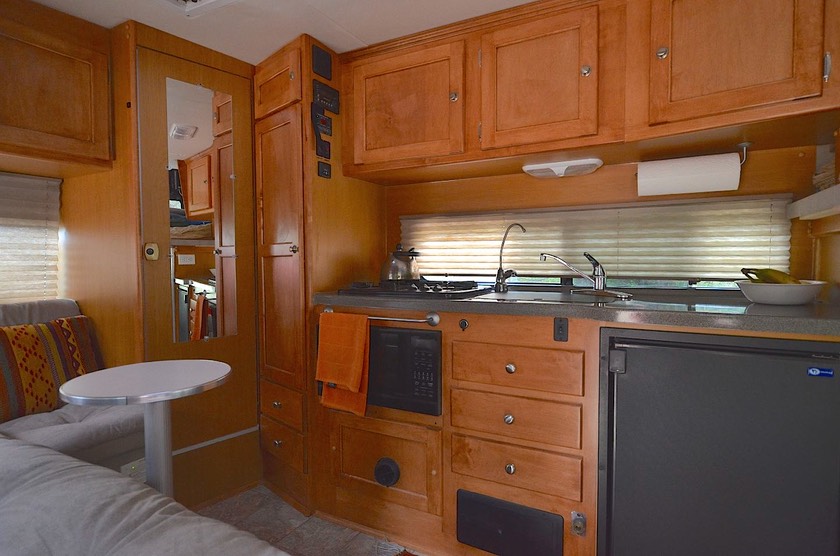
Relocating our inverter from the closet, where it took up a complete shelf, to the space previously occupied by the generator was an obvious move and still left lots of added storage space in the former generator area, which we had converted to an interior space, sealing off the original outside access. Doubling up on both battery capacity and solar charging ability will improve our capacity to do what we love most; parking out in the wild without need for campground services. As a side benefit to our systems changes, with the help of Ron at D&R we were able to sell our generator and the two older solar panels for enough to cover the cost of the three new panels.
Installing a diesel furnace and the electric water heating option, together with the removal of the generator, will all serve to greatly diminish our reliance on propane as a fuel source. We still need it for our cooktop and for some of our water heating needs, but that is all. In the over fifty countries we have visited, only two did not have propane available; nonetheless, needing to find new supplies of any fuel less often is a good thing and we look forward to seeing how long our tank will last given our reduced usage of LPG.
So now that this work has all been done, how are things working? Excellent on all fronts. The technical changes and upgrades are performing as hoped and, as mentioned already, our Tiger is looking better than ever. We are very happy with everything that has been done and have already begun the task of replacing the sticker collection that we lost with the removal of the old top.
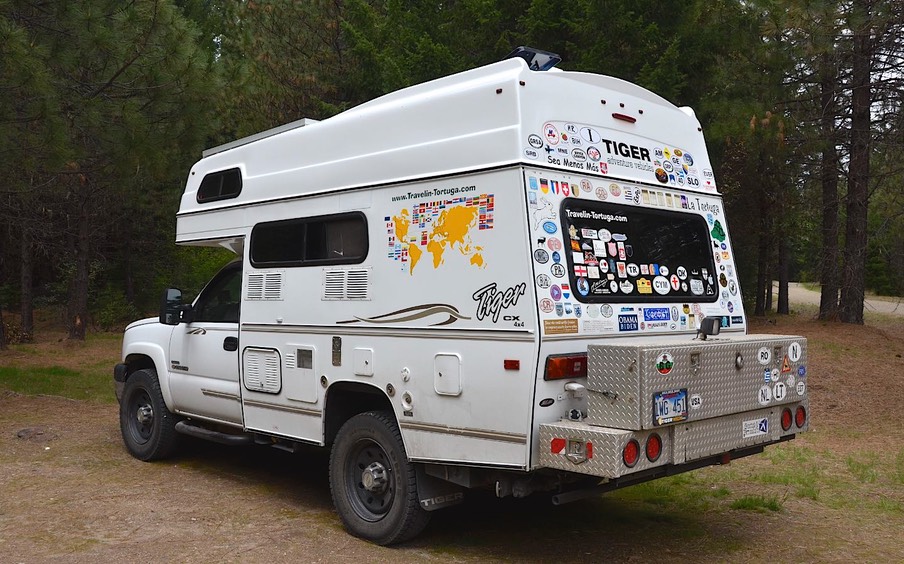
Over the course of the next several months, in addition to simply enjoying our Tiger as we travel in the western US, we will be tackling a series of mechanical improvements which, hopefully, will bring the Chevrolet components of our Tiger up to the high standards set by the refurbishment of the living quarters. We plan to do complete servicing and inspection of all the mechanical components and systems, along with upgrades and improvements where needed. We particularly hope to make improvements to our Tiger’s suspension, brakes, and four wheel drive systems as well as improving our exterior storage capabilities.
Go to Part Two of this report for the story on work done to complete these tasks.
Viva La Tortuga!